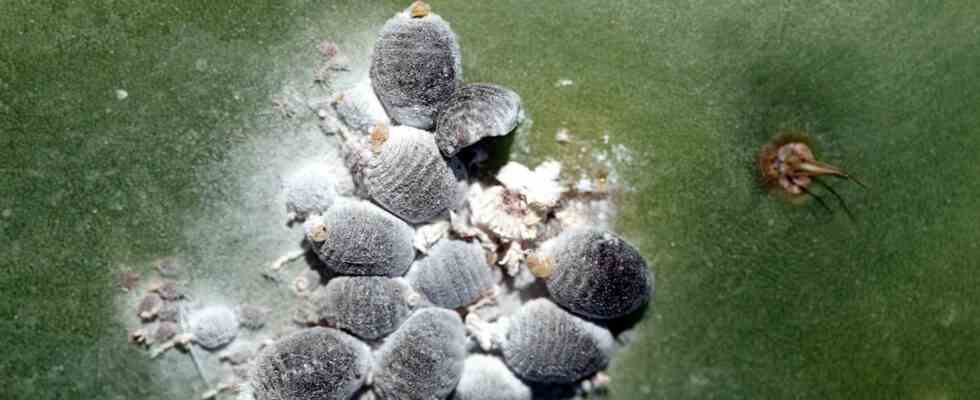Status: 07.02.2023 2:38 p.m
When crickets were recently approved as a food, there was a lot of excitement. Ground lice or insect excretions are already found in many foods. An overview.
“Real carmine” or E120 – this natural food coloring can be found in ketchup, jam or gummy bears, for example. Carmine is obtained from lice, more precisely from the cochineal scale insect, which lives on a type of cactus found primarily in South and Central America. The female lice are dried and ground to create the light to bright red food coloring.
If you want to do without the animal additive carmine as a coloring agent, you should pay attention to the synthetic variant E124 in the list of ingredients, which can be obtained from beetroot, for example. In addition to food, carmine is also frequently used in cosmetics or as a dye for medicines and textiles. Incidentally, real carmine from the cochineal louse is the only permitted dye of animal origin.
Aphid excretions in honey
Lice are not only responsible for the dye in certain foods. Your excretions also find their way onto the breakfast table – for example in forest honey. For this type of honey, the bees do not collect nectar from flowers, but honeydew – sugary excretions of the aphids that sit on the leaves of the plants.
Aphids are equipped with a proboscis, which they use to prick the leaves and suck out the cell sap. It consists of a small proportion of amino acids and plenty of sugar. The amino acids are vital for the louse to meet their nitrogen needs. The excess sugar is excreted and collects as honeydew on the leaves of the plant. For the darker forest honey, the bee does not collect nectar, but the droppings of lice.
Chewing gum shines thanks to lice
And also many sweets, as well as tablets or cigarettes, cannot avoid the louse. Shellac, for example, is a resin that female scale insects secrete to protect the eggs they lay. After about half a year, the lice hatch and the resin-coated leaves are harvested: the starting product for shellac production.
Shellac is a precursor to many synthetic resins, although it is still used in its original form today. Today, the resin makes chocolate dragees, chewing gum or tablets shiny or is used as an adhesive in cigarettes. Shellac hides behind the number E904.
Cockchafer soup popular until the 1950s
So insects have been eaten for a long time – consciously or unconsciously – and are part of our eating culture, including western ones. In 1844, for example, the Magazin für Staatserzneikunde recommended May bug soup as an “excellent and hearty food”. Thirty beetles per person were to be caught, washed and pounded in a mortar, then fried in butter and boiled in broth. According to the nutritional sociologist Daniel Kofahl from the University of Vienna, this dish was popular in Germany until the 1950s. Candied cockchafers were therefore also popular as dessert.
Sociologist: Excessive excitement about insects
Nevertheless, the approval of crickets as food last week caused some excitement. The Bavarian Economics Minister Aiwanger wrote, for example, that people were fed up with the criticism of the consumption of beef or pork, “but insects should be in the food”. It “should be ‘in’ so vegans can get their animal protein,” he wrote – but obviously ignored the fact that vegans don’t eat any animals, including insects.
The nature of the outcry was surprising, said Kofahl Deutschlandfunk. “Because it comes from people who otherwise eat a totally omnivorous diet and are pretty proud of it.” Only with insects would they get “the big flutter”. The fact that there has been a trend towards eating insects again in recent years “also has to do with the fact that people are traveling more”. African or Asian countries, where the consumption of insects is partly a tradition, are becoming more aware of their food cultures.
What is behind the E numbers?
Some additives made from insects are marked with E numbers – there are over 300 of them in total. They are used in the EU to label additives in food. The European Food Safety Authority is responsible for approval. Approval is only granted if the substance is demonstrably harmless to health and technically necessary.
In general, a distinction is made between colorants, sweeteners and “other additives” with the E numbers – the largest group. These include preservatives, humectants or acidifiers.
Pork bristles in bread
But other animal parts are also used in surprising places, such as L-cysteine. The amino acid is used in large bakeries and affects the consistency of the dough, making it easier to knead. This substance, better recognizable by the E number 920, is often made from pig bristles or feathers. The proteins it contains are boiled in hydrochloric acid, which breaks down the individual amino acids. The mixture is then electrochemically reduced to cysteine.
According to the EU food regulation, E920 does not have to be declared because it only gets into the end product via one ingredient, in this case flour. That’s why it’s called a “technical ingredient” and not an additive. If you want to be sure that no L-cysteine has been added to a food, you can use organic products. L-cysteine is not permitted as an additive for organic products.

